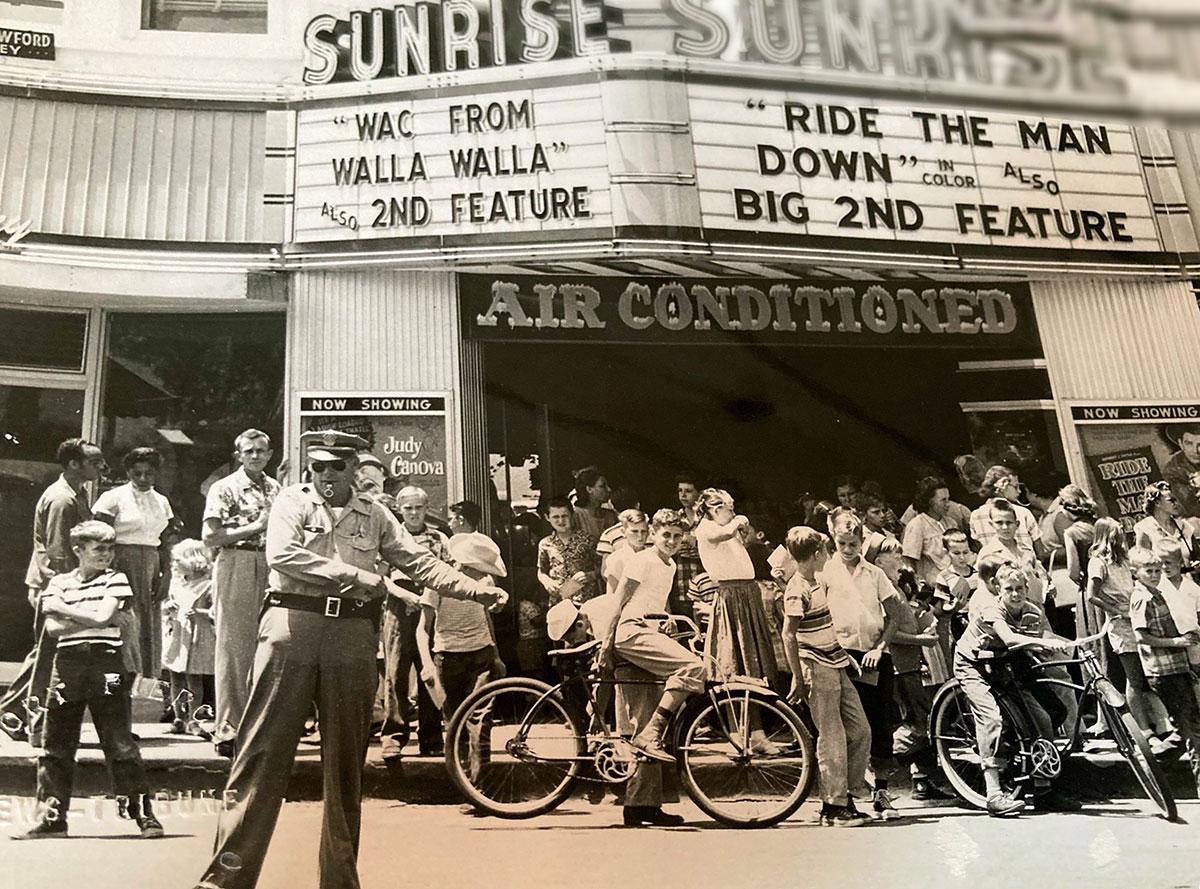Recalling a lifetime at the Sunrise Theatre

BY GREGORY ENNS
As millions of people watched their television screens to see Neil Armstrong and Buzz Aldrin land the Apollo Lunar Module Eagle on the moon July 20, 1969, I was watching a different screen.
I was at the Sunrise Theatre in downtown Fort Pierce, seated in the middle of the theater, watching a double bill: The Beatles’ Yellow Submarine and Don Knotts in The Love God. I remember my dad picking us up at the Sunrise that day and telling us that man had landed on the moon. I’m not sure that I responded with anything but disappointment that the Don Knotts in The Love God wasn’t the same one I knew in The Andy Griffith Show.
As a child growing up in Fort Pierce five blocks from the Sunrise, the theater became an extension of my living room. First there were the Saturday matinees and then Friday or Saturday night movies.
The Sunrise was where I got my first real job at 13, inheriting the task from my older brother, Chuck, of changing the theater’s marquee every Thursday night after the start of the last show before the next day’s change of movies.
For changing the marquee, I earned the princely sum of $3, or $2.82 after Uncle Sam took out his share. The money — two $1 bills and 82 cents in change — was always awaiting me in a small envelope atop the cabinet where the steel letters for the marquee were kept.
Later, in high school, I became a doorman, usher and concessionaire. As doorman, all I had to do was tear little red tickets and sweep popcorn off the lobby carpet. I was required to wear a tie, and I confess to donning the same red clip-on for every shift. As usher, I had to patrol the theater a couple of times during the show and keep kids from buying cigarettes from the vending machine or hanging out in the smoking section, which was on the theater’s east side.
The worst shifts were Saturday matinees. The concession would be packed with little kids waiting in line and once they got to the front of the line they’d forget what they wanted or were too flummoxed to say what they wanted. Inside, the theater floor would be so tacky with soda and candy that you could barely move your feet.
My friend Terry Bloehm [King] also worked at the theater, and when working the concession we were instructed to put leftover popcorn from the night in a large trash can with a plastic liner to be used the next day. Sometimes, when a clunker or series of clunkers were booked, few people would visit the theater and we’d barely sell any popcorn, so the same popcorn was going in and out of the can, sometimes for weeks. It taught me a valuable lesson as a consumer: always ask for fresh popcorn and inquire when it was popped.
More of my friends began working at the theater as I approached my senior year of high school, including John Gorham, Bonnie Jacobus [Gray] and Nanette Macon [Sample]. We worked for a lady named Ruby Novak, whose husband, Ed, oversaw all the Kent Theatres operations in Fort Pierce, including the Fort Pierce Drive-In and the Angle Road Drive-In. Ed tended to the drive-ins while Ruby tended to the Sunrise and us.
Ruby had gotten rid of a lot of the longtime employees there and everybody subsequently hired by her seemed to run a course of a year or less.
Ruby chain-smoked Pall Malls and held forth in her smoke-filled office upstairs, which had a walk-in safe. When Ruby wasn’t at the Sunrise, she spent a lot of time drinking coffee at Donut Circus on U.S. 1 and the Crystal Restaurant down the street from the Sunrise.
She was a small woman, about 4 feet 10, and always wore pumps and clothes she bought next door at Rosslow’s. Sometimes before the start of a movie, she’d stand near the ticket box with an adoring look at the people coming in. And sometimes she’d do what could be called Koblegard catching.
The members of the Koblegard family — patriarch R.N. “Pop’’ Koblegard opened the Sunrise in 1923 — always got into the theater for free because they owned the building and leased it to Kent. When Ruby would see Koblegards standing in line, she’d pull them out and walk them into the lobby, giving them the VIP treatment.
I also confess a certain fondness for the Koblegards. Hanging out at the studio of artist A.E. “Bean’’ Backus as a youngster, I remember his fond recollections of Pop Koblegard, whom he placed in a pantheon with his Uncle Reg Goodwin, who was not a real uncle at all, and his Uncle Al Hoofnagle, same case.
I never realized how far back my family went with the Koblegards until reporting the Pop Koblegard story in this issue. A year after his first visit to Fort Pierce in 1906, Pop commissioned my great grandfather, boat builder R.R. Gladwin, to construct a 25-foot cabin launch for him. After selling the boat business to George Backus, R.R. unwisely went into the hardware business, operating the Jackson-Luce-Gladwin Co.
The store went broke about 1915 and R.R. had to move his family, which included my grandmother, out of their home on South Indian River Drive. Pop Koblegard apparently came to the rescue.
“Thanks to Mr. Koblegard we got 80 acres in the new drainage district in Fort Pierce that he and Mr. Armstrong were promoting,’’ my great uncle, Bob Gladwin, wrote in his memoir shortly before his death in 1988. The district was Fort Pierce Farms, where R.R. successfully planted a citrus grove that would hold the family in good stead for several decades.
Back at the Sunrise, when not on Koblegard alert, Ruby was always telling us about some guy named Grayson with whom she had a direct line at the Kent Theatres headquarters in Jacksonville. According to Ruby, Grayson would send undercover operatives into the theater. Posing as regular theater patrons, they would stealthily go over operations and report their findings to Grayson, who would pass them on to Ruby. From these, Ruby would tell us of her concern of a cashier who didn’t count money back to the customer or a concession worker who was drinking soda behind the counter or a slovenly usher.
I don’t think any of us believed the reports but they did keep us on our toes and left us slightly paranoid, wondering whether a certain customer might be on a mission from Grayson.
Thankfully, by my senior year, I had worked my way up to the projection booth and out of sight of Grayson’s operatives. I was making $5 per hour, unheard of for a 17-year-old in 1976, when the minimum wage was $2.30. Many projectionists belonged to a union and Kent Theatres was trying to keep the union out of their booths.
Before xenon bulbs came into widespread use, the old projectors I ran still had carbon lamp houses, with the fire from positive and negative carbons and a mirror creating white light bright enough to light the screen. The carbon rods were moved automatically as they burned but you still had to occasionally check on them through a small viewer window to make sure the gap between the rods was optimal. If they got too far apart, the fire would go out.
The new films arrived every Thursday in the back of a long trailer pulled by a truck cab. Why Kent Theatres had to use such a big truck to deliver their films I don’t know.
Back then the 35-millimeter films came on 20-minute reels. You had two projectors, that you switched over every 20 minutes. About a minute before the reel would end, a bell would go off indicating the reel was nearing its end. You had the next projector threaded and ready to go, so when you saw a circle at the upper right of the screen you started the new projector so that it was running. When a second circle would show up 10 seconds later, you simultaneously hit a pedal that would close the aperture on the projector running out of film and hit a switch to stop it while opening the projector with the new 20-minute roll. If you did everything right, the audience wouldn’t be able to tell that a reel had changed.
Then you rewound the spent film while threading a new roll into the stopped projector. The whole changeover process took a total of about 5 minutes, which meant you had the next 15 minutes to do nothing except occasionally monitor the carbon gap. I’d usually watch each film about once and then read, mostly the science fiction of Robert A. Heinlein.
Before and during shows we played the music of pianists Ferrante and Teicher, who had once performed at the Sunrise. I think that music had been playing back in my days attending matinees. After I got comfortable as projectionist, I changed the music to trumpeter Maynard Ferguson, who I was listening to at the time. I don’t think Ruby noticed because I never heard her complain.
By graduation, my course with Ruby and the Sunrise ended and I took a job at Boogart’s grocery store, where I got more hours and made more money before leaving for college that fall.
Looking back on it, my time with Ruby wasn’t so bad. On slow nights, she would spring for pizza for the staff at Barro’s, a new pizza joint in town, and the good-paying projectionist job she gave me in high school enabled me to get a projectionist job while in college.
After graduation, I came back to Fort Pierce to work as a reporter for The News-Tribune. Sadly, in 1983, I had to report the close of the theater I loved and grew up with before moving on to another job on Florida’s west coast. I returned in 2006 to once again live in Fort Pierce, and by coincidence, it was the same year the Sunrise, after an $11 million renovation, reopened after 23 years of being shuttered.
During that first year, the Treasure Coast Opera, which had been performing in the boxy St. Lucie County Civic Center, moved to the Sunrise. I brought my daughter, Lucie, a junior in high school, with me to one of its performances of La Boheme. Listening to Puccini and seeing the beauty of the opera performed in my house — the Sunrise Theatre — I realized I had made the right decision to return home and start a magazine company. As my daughter slept in the seat next to me, I wept.
I was moved at that moment, and I realized that the magic of the Sunrise, which opened exactly 100 years ago come Aug. 1, is that it has created moments like that night for thousands of other patrons. They will always associate the theater with that great memory and others, and their affection for the theater will only deepen. Happy birthday, old girl.

Gregory Enns
Reach Gregory Enns or 772.940.9005.
See the original article in print publication
SHARE YOUR MEMORIES
As the 100th anniversary of the opening of the Sunrise Theatre approaches Aug. 1, share your memories of the Sunrise at https://indianrivermagazine.com/i-remember-the-sunrise and read other memories at https://indianrivermagazine.com/i-remember-the-sunrise-contest-winners/
May 2023
